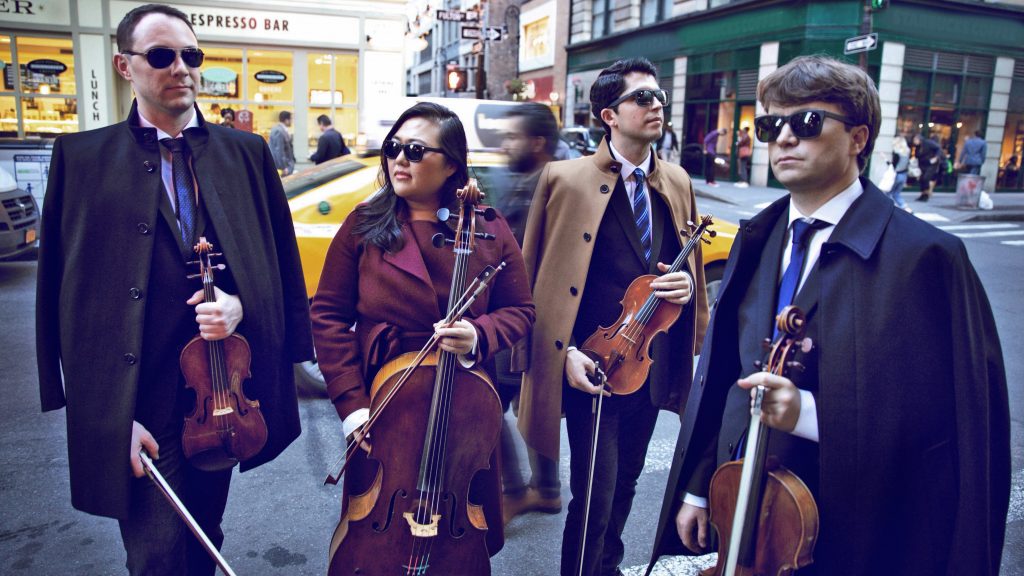
By Dennis D. Rooney
Founded in 2010 at Los Angeles’s Colburn Conservatory of Music, the Calidore String Quartet’s name is a pastiche of “Cali(fornia)” and “doré,” French for “golden.” Now based in New York, it has garnered a brace of prestigious awards and recently completed a residency with the Chamber Music Society of Lincoln Center II.
The group’s concert Sunday at the Society of the Four Arts in Palm Beach was the Calidore’s third local appearance, and they offered a meaty program indeed, which opened with Haydn’s Quartet in D (Op. 64, No 5) which has the nickname “Lark” on account of the trilling and twittering in the first violin part. It is one of six quartets that Haydn composed in 1790 and dedicated to Johann Tost, once a violinist in Haydn’s orchestra at Eisenstadt who left to become a merchant and entrepreneur.
Because Tost was able to arrange publication of many of the composer’s other quartets, Haydn dedicated his Op. 64 set to him. The members of the Calidore — violinists Jeffrey Myers and Ryan Meehan; cellist Estelle Choi; and violist Jeremy Berry, seated onstage in that order — offered cultivated tone and nice attention to dynamic contrasts throughout its four movements. First violin Myers plays with a certain tonal austerity, which undervalued the cantabile in the Adagio; however, the Scherzo and Vivace finale had excellent spirit.
Haydn was followed by Shostakovich, his 1961 Quartet No. 9 (in E-flat, Op. 117), which replaced an earlier ninth quartet that dissatisfied him, whereupon he burned it. The replacement consists of five marked movements linked together. The opening Moderato con moto plays around with the composer’s “musical signature,” the pitches D, E-flat, C and B that form his first initial and the first three letters of his surname in German spelling (DSCH).
Unlike his Eighth Quartet from the previous year, in which those pitches are ubiquitous, in the Ninth he merely alludes obliquely to them, sometimes in various inversions. The smooth opener leads to an Adagio in which the cantabile gradually gathers speed to launch the Allegretto third movement, mostly scherzo-like but with the addition of klezmer elements and hints of Rossini’s William Tell overture. The tempo slows to introduce a second Adagio and the texture becomes homophonic and suggests liturgical chant.
It eventually wends its way to the Allegro finale, which itself consists of five sections and is the longest movement of the work. In a quiet passage for cello that follows a fugue, cellist Choi ran into some trouble that affected both her harmonics and some pitches. It was the only blemish on the Calidore’s otherwise compelling account of a work that many in the audience found a tough nut to crack. Nevertheless, they remained quiet and no cellphones rang.
After intermission came another challenging work: Beethoven’s Quartet in F (Op. 59, No. 1), one of a set of three works from 1806, commissioned by and dedicated to Count Andreas Kirillovich Rasumovsky, the Russian ambassador to the Habsburg Court in Vienna. They were published in 1808 and are the first quartets from his middle period. Together with such coeval works as the Third and Fourth Symphonies, and Piano Concertos Nos. 3 and 4, they share a preoccupation on expanding all elements of form, harmony and instrumental character.
Whereas Beethoven’s Op. 18 Quartets were works anchored in the 18th century, the Op. 59 set looks ahead. In the process, Beethoven’s executive and expressive demands on his performers bore down relentlessly. The Quartet in F, which lasts nearly twice the length of any Haydn quartet, begins modestly with a tune heard in the cello and later shared by the violins and viola. It is subjected to much development, in the course of which Beethoven dispenses with the customary exposition repeat. The succeeding scherzo is highly rhythmic and jokey, while the Adagio molto e mesto that follows it is the longest of the four movements.
In the extended cantabile played by the first violin, I wished for more legato phrasing from Myers, who seemed inclined to a choppiness that didn’t suit the material. However, in the 32nd- and 64th-note passages near the end of the movement (which are closely related to similar passages in the Violin Concerto, Op. 61) he played expressively and highly effectively, as the movement led, attacca, to the Thème russe that opens the Allegro movement. Count Rasumovsky stipulated that Beethoven put a Russian theme in each of “his” quartets. Beethoven claimed to have found the theme in a book of Russian songs, although it is unidentified. Apparently, it seemed genuine enough to please the count.
The Calidore’s entire performance was distinguished by both firm control of formal elements and superbly proportioned ensemble sonority ideally suited to chamber music, a quality not so commonly encountered as it ought to be. Perhaps Choi could have supplied a stronger harmonic foundation in many places but it was a small lack when compared to their outstanding instrumentalism displayed throughout.